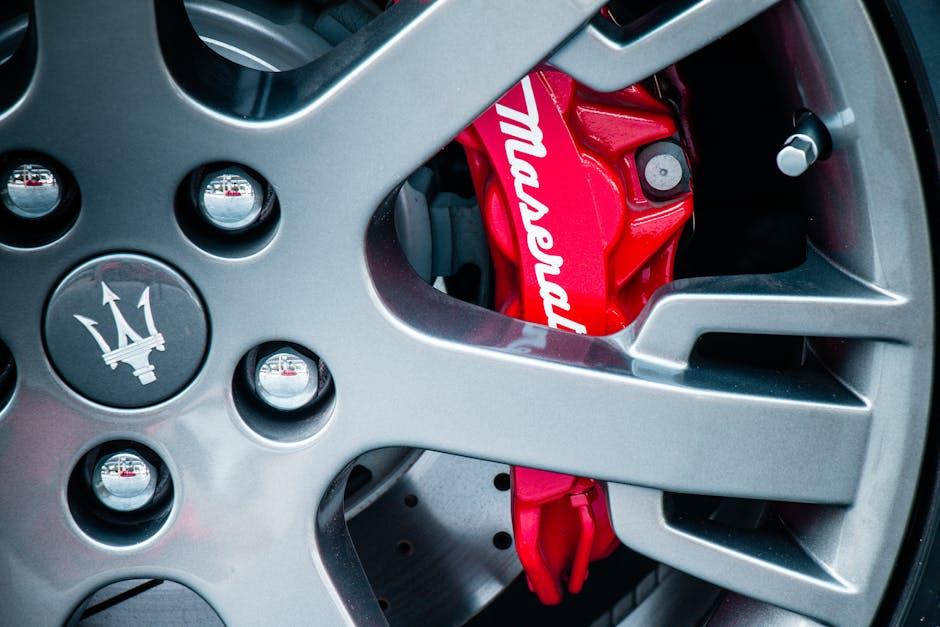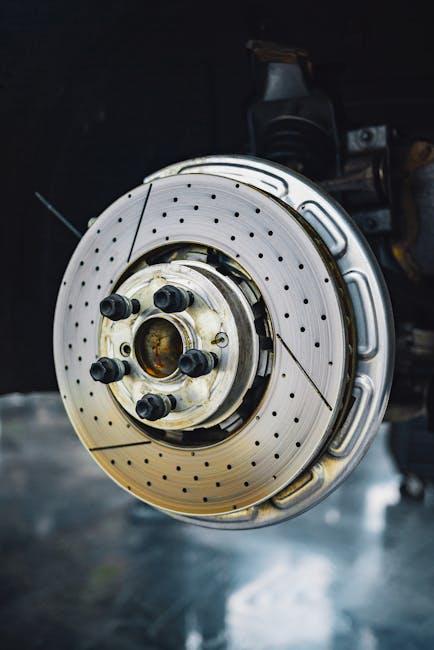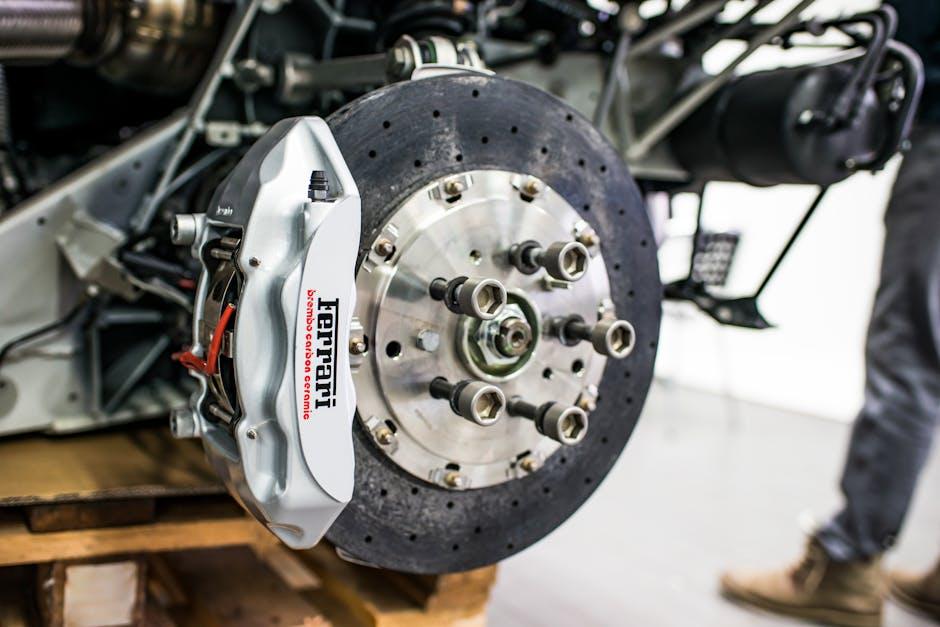Imagine you’re cruising down a quiet street, the world outside a blur of colors and sounds. Suddenly, you press the brake pedal, expecting a smooth and steady stop—but instead, your car hesitates or shudders. It’s a subtle warning your vehicle is sending, a quiet alert that your brakes might be crying out for help. Brakes are your car’s most crucial safety feature, and recognizing the early signs of trouble can mean the difference between a safe journey and a dangerous one. In this article, we’ll explore how to tell if your brakes need repair, helping you listen closely to your car’s signals before it’s too late.
Table of Contents
- Signs Your Brake Pedal Is Trying to Tell You Something
- Unusual Noises and What They Mean for Your Brake System
- Understanding Brake Fluid and Its Role in Safe Stopping
- The Importance of Brake Pad Thickness and When to Act
- How Brake Vibration Can Indicate Deeper Issues
- When to Visit a Professional for a Comprehensive Brake Check
- Q&A
- The Conclusion

Signs Your Brake Pedal Is Trying to Tell You Something
When pressing the brake pedal feels different than usual, it’s a clear message from your vehicle. A pedal that sinks too far down or feels spongy could mean there’s an issue with the brake fluid or air trapped in the lines. On the other hand, if the pedal feels unusually stiff or requires extra effort to press, this might indicate problems with the brake booster or a mechanical fault. Ignoring these sensations can lead to compromised safety, so paying attention to how your brake pedal behaves is crucial.
Some of the subtle warnings your pedal might give include:
- Vibration or Pulsation: You might feel a rhythmic shaking through the pedal, often caused by warped brake rotors.
- Delayed Response: The pedal travels normally but the brakes engage slower than expected, hinting at worn brake pads or fluid leaks.
- Unusual Noises: Squealing or grinding sounds when pressing the pedal often mean the brake pads are dangerously thin.
| Brake Pedal Feeling | Possible Cause | Suggested Action |
|---|---|---|
| Soft or Spongy | Low Brake Fluid / Air in Lines | Check fluid levels, bleed brakes |
| Hard to Press | Brake Booster Malfunction | Professional brake system inspection |
| Vibrations | Warped Rotors | Resurface or replace rotors |

Unusual Noises and What They Mean for Your Brake System
When your brake system starts to communicate in unfamiliar sounds, it’s essential to pay close attention. Squealing noises often indicate that your brake pads are wearing thin, triggering the built-in wear indicator to alert you that replacement is near. A metallic grinding sound usually spells trouble; this harsh noise means the brake pads might be completely worn down, causing metal to grind against metal. Another less common but concerning sound is a high-pitched chirp, which might suggest that dust or debris has lodged in the brake components, impairing their function.
To help you diagnose these warning sounds quickly, consider the following breakdown of noises and their likely causes:
| Noise | Probable Cause | Immediate Action |
|---|---|---|
| Squealing | Worn brake pads | Schedule brake inspection |
| Grinding | Brake pads worn to metal | Stop driving; urgent repair |
| Chirping | Debris or dust in brakes | Clean or repair brakes |
| Thumping | Warped rotors | Rotor replacement recommended |

Understanding Brake Fluid and Its Role in Safe Stopping
Brake fluid is the unsung hero of your vehicle’s braking system, transmitting force from your brake pedal to the brake pads that stop your wheels. It’s a specialized hydraulic fluid, designed to withstand high temperatures and maintain consistent pressure under extreme conditions. Over time, however, brake fluid can absorb moisture from the air, which significantly diminishes its effectiveness and can lead to corrosion in critical brake components. Regularly checking and replacing brake fluid is essential—not only does it ensure your brakes respond promptly, but it also helps prevent costly repairs down the road.
Knowing the signs that your brake fluid is compromised can save you from dangerous situations on the road. Here are some key indicators to watch for:
- Spongy or soft brake pedal: This sensation often means there’s air or moisture in the brake fluid.
- Brake warning light: A dashboard alert may illuminate if fluid levels are low or if there’s a system fault.
- Brake fluid discoloration: Old or contaminated fluid typically appears dark or murky instead of clear or amber.
| Brake Fluid Type | Boiling Point (°F) | Recommended for |
|---|---|---|
| DOT 3 | 401 | Standard passenger vehicles |
| DOT 4 | 446 | Higher performance and newer cars |
| DOT 5 | 500 | Military and classic cars (silicone-based) |

The Importance of Brake Pad Thickness and When to Act
Brake pad thickness is a critical factor that directly affects your vehicle’s stopping power and overall safety. Over time, these pads wear down due to regular use, reducing their ability to create the friction necessary for effective braking. When the thickness reaches a dangerously low level, not only does braking efficiency deteriorate, but the risk of damaging other brake system components increases. Regularly checking brake pad thickness helps you maintain optimal performance and avoid costly repairs down the road.
Knowing the signs of when to replace brake pads can save you from unexpected failures. Typically, pads should be replaced when their thickness falls below 3 millimeters. Some telltale symptoms include:
- Squealing or screeching noises during braking
- Increased stopping distance
- A vibrating brake pedal
| Pad Thickness | Action |
|---|---|
| 6 mm or more | Monitor regularly |
| 3-6 mm | Plan replacement soon |
| Less than 3 mm | Replace immediately |

How Brake Vibration Can Indicate Deeper Issues
When you feel that unsettling shake or vibration every time you press the brake pedal, it’s more than just a minor annoyance—it often signals an underlying problem in your brake system. This unpleasant wobble can result from warped brake rotors, which occur due to uneven heat distribution during braking. Over time, this warping disrupts the smooth contact between the rotor and brake pads, causing that distinctive pulsation you can both see and feel. Another usual culprit is imbalanced braking components, where uneven pad wear or loose hardware leads to inconsistent braking pressure, translating into that noticeable shudder.
Ignoring these vibrations can escalate the wear on critical parts and compromise your vehicle’s safety. Here’s a quick rundown of what these tremors might tell you:
- Rotor issues: Warping or grooving affecting smooth braking.
- Brake pad wear: Uneven surface causing uneven pressure.
- Caliper problems: Sticking calipers causing uneven force application.
- Wheel alignment: Misalignment can exacerbate braking unevenness.
| Source of Vibration | Typical Cause | Effect on Braking |
|---|---|---|
| Warped rotors | Uneven heat stress | Pulsing brake pedal |
| Worn brake pads | Uneven wear pattern | Inconsistent stopping power |
| Sticking calipers | Corrosion or debris | Uneven brake force |
| Wheel misalignment | Suspension wear | Vibration during braking |

When to Visit a Professional for a Comprehensive Brake Check
Knowing the right moment to consult a professional can save you from expensive repairs and ensure your safety on the road. If you notice any persistent symptoms such as squealing or grinding noises, vibrations when applying brakes, or a longer stopping distance, it’s wise to schedule a thorough brake inspection. Don’t wait for the warning lights on your dashboard to illuminate; early intervention can prevent minor issues from escalating into major failures. A certified mechanic will assess every component, ensuring your brake system is in optimal shape.
Some subtle signs to watch out for include:
- Uneven brake pad wear that affects vehicle stability
- Soft or spongy brake pedal feel, indicating fluid leaks or air in the system
- Pulling to one side when braking, which may suggest caliper problems
Professional checks typically involve:
| Inspection Area | What Mechanics Look For |
|---|---|
| Brake Pads & Shoes | Thickness and wear patterns |
| Rotors & Drums | Surface condition and warping |
| Brake Fluid | Level and contamination |
| Brake Lines & Hoses | Leaks and cracks |
Q&A
Q&A: How to Tell If Your Brakes Need Repair
Q1: What are the most common signs that my brakes might need repair?
A1: Your brakes often send subtle (and sometimes not-so-subtle) signals when something’s wrong. Listen for squeaking, grinding noises, or a high-pitched screech when you press the pedal. Notice if the brake pedal feels spongy, soft, or travels too far before it “bites.” Also, watch out for a strange vibration or pulsation in the brake pedal or steering wheel when braking. Any of these could mean your brakes need attention.
Q2: Can a visual inspection help me know if my brakes are wearing out?
A2: Absolutely! If you’re comfortable peeking behind the wheels, look for brake pads thinner than about a quarter-inch. Also, check for rust or leaks around the brake components. Uneven wear or grooves on the rotor surface are another red flag that repairs may be necessary.
Q3: Is it normal for brakes to make noise occasionally?
A3: A little noise here or there can be normal—especially if it’s just a light squeak after rain or temperature changes. However, persistent, loud, or grinding noises are your brakes’ way of waving a red flag. Don’t ignore these sounds; they often mean worn brake pads or other issues in need of repair.
Q4: Can brake problems affect the way my car drives?
A4: Yes! If you feel your car pulling to one side when you brake, that’s usually a sign of uneven brake wear or a sticking caliper. Reduced braking power, longer stopping distances, or a brake warning light on the dashboard are clear signs that your braking system isn’t performing optimally.
Q5: How urgent is it to get my brakes checked if I notice these signs?
A5: Brakes are one of your vehicle’s most critical safety systems. Don’t delay. As soon as you notice any unusual sounds, feelings, or performance changes, it’s time to visit a trusted mechanic. Early repairs can prevent bigger, more expensive problems — and keep you safe on the road.
Q6: Can I repair my brakes myself, or should I always consult a professional?
A6: While some car enthusiasts might tackle basic brake maintenance at home, brakes are complex and vital. If you’re not experienced, it’s safest to have a professional diagnose and repair any issues. Your safety depends on it!
Q7: How often should I have my brakes inspected?
A7: A good rule of thumb is to have your brakes checked every 10,000 to 15,000 miles or during routine oil changes. But if you notice any warning signs sooner, get them inspected right away. Regular check-ups can catch wear before it turns into a major problem.
If your brakes start to talk—whether through sound, feel, or performance—listen carefully. Timely attention and repair keep you in control and your journeys safe.
The Conclusion
In the grand symphony of your vehicle’s performance, your brakes play the crucial role of the conductor—guiding, controlling, and keeping every journey safe and smooth. By tuning in to the subtle signs of wear and tear, from unusual noises to changes in pedal feel, you can ensure that your brakes continue to perform their vital task. Remember, when it comes to brake maintenance, a little attention today can prevent a lot of trouble tomorrow. Stay alert, stay safe, and let your brakes keep the rhythm of the road in perfect harmony.

